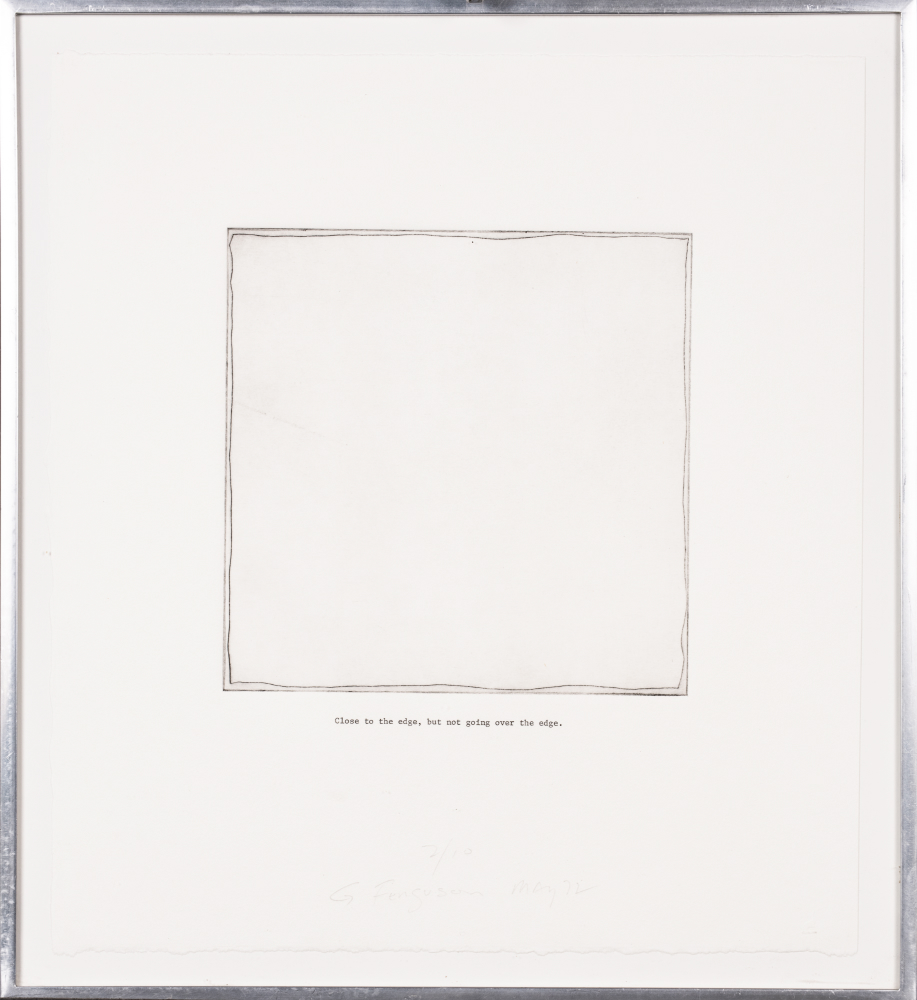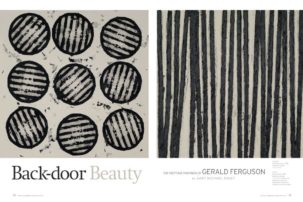The work itself is unprepossessing—a small grey square, printed on rag paper, with a darker line meandering around its edges—but its implications in the career of one of Canada’s leading contemporary artists are profound.
In 1972, Gerald Ferguson took a six-inch-square copper plate, and using a stylus traced the shape of the plate, as close to the edge as he could go without slipping over it. The resulting dry-point etching was printed in an edition of ten. Ferguson typed the title on each print: “Close to the edge, but not going over the edge.” As he later wrote of the title, “It functioned well visually and as a self-parody and would later serve as a procedure and attitude in paintings that I began in 1972.”
That procedure and attitude is well represented in the retrospective exhibition that takes its name from that print. “Close to the Edge… The Work of Gerald Ferguson” represents Ferguson’s work from his arrival in Halifax in 1968 to take up a teaching post at the Nova Scotia College of Art and Design until his death in 2009. Over that period, he built a career as one of the country’s leading artists, and a reputation as an art teacher whose combination of rigour and generosity made him an invaluable mentor to generations of Canadian artists.
The exhibition, curated by David Diviney, curator of Modern and Contemporary art at the AGNS, and himself a former student of Ferguson’s, is in three parts, each comprising distinct phases in Ferguson’s oeuvre. The first features what one could call his “high modernist” phase, with the stark conceptualism of the late 1960s, ’70s and ’80s. The largest section is taken up with Ferguson’s response to post-modernism and the trend back toward figuration in painting—his stencil and frottage works (made by passing rollers charged with black paint over canvas that itself covers objects such as chain, clothesline and drain covers). The final section is given over to Ferguson’s later works, including frottage on tinted canvas and his late landscape paintings.
Built primarily from the AGNS’s permanent collection, Ferguson’s prolific practice is represented by just a few examples of each series. This sparseness is elegant and minimal, very much in keeping with the aesthetic of Ferguson’s work. Including such well-known works as 1,000,000 Pennies (1979), Halifax City Hall – A Painting (1980) and an excerpt from his monumental series 1,000,000 Grapes (1997), the exhibition, the first full-career survey since the artist’s death, is both a timely reminder of, and an important introduction to, the work of one of Canada’s most thoughtful painters.

Gerald Ferguson, Close to the edge, but not going over the edge, 1972. Drypoint on paper, 2/10, 20 x 20 cm. Collection Art Gallery of Nova Scotia. Photo: Steve Farmer.

Gerald Ferguson, 144 Cast Iron Flowers (detail), 1993. Painted cast iron mounted on steel rods, Dimensions variable. Collection Art Gallery of Nova Scotia. Photo: Steve Farmer.

Gerald Ferguson, 1,000,000 Grapes (excerpt), 1996–97. Enamel on canvas, 10 panels, 1.22 x 1.22 m each. Collection Art Gallery of Nova Scotia. Photo: Steve Farmer.

Gerald Ferguson, Nine Drain Covers, 2006. Acrylic enamel on canvas, 1.21 x 1.21 m. Collection Dalhousie Art Gallery. Photo: Steve Farmer.

Installation view of "Close to the edge... The Work of Gerald Ferguson" at the Art Gallery of Nova Scotia, 2018. Photo: Steve Farmer.








